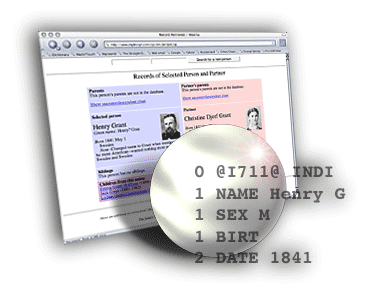- What is PerlGed?
- PerlGed is a script that creates Web pages based on info from a GEDCOM file. Nearly all genealogy programs today can export information in the GEDCOM format, creating a single plain-text file. PerlGed pulls information from such a file and creates Web pages on the fly to display individual and family records and simple ancestor charts.
- Aren’t there other sites/programs that do this?
- Yes and no—I couldn’t find a solution that did exactly what I wanted, so I wrote my own (with debugging assistance from Ed Piou, of eppi, Inc.). Major sites like RootsWeb.com or GenCircles will let you upload a GEDCOM file and then create Web pages from them, but I found the visual display rather antiseptic. Other programs let you generate customizable Web pages from a GEDCOM file, but I didn’t want hundreds or thousands of separate pages that might need to be individually updated. The best alternative, developed since PerlGed’s introduction, is PHPGedView, an excellent open-source project that uses PHP instead of Perl and offers far more functionality. It’s overkill for my purposes, and I prefer my own layout of information. I also wanted a pedigree chart that showed siblings, which apparently serious genealogists don’t do.
- Can I use PerlGed on my Website/computer?
- Sure, with some caveats:
- You need Perl. Most ISPs hosting Websites do have Perl, so you’re probably in luck. Still, you may not have CGI access to Perl if you’re just a dial-up user with some server space for a small site. Ask your ISP. If you have Perl installed on your home computer (standard with Unix, Linux, Mac OS X), you can use PerlGed locally.
- PerlGed is shareware, so if you use it for any length of time please send US$5.00 via PayPal using the email address <ebay at etgdesign dot com>. Or write me at that address to ask about sending a check instead. And thank you for supporting shareware!
- Anything else I need to know?
- GEDCOM is a highly mutable standard, and each program tends to generate different code. I haven’t tried to account for all variations. PerlGed is a work in progress, so it doesn’t handle all GEDCOM tags yet. I may or may not update PerlGed, but paid users will never be asked to pay for an upgrade. PerlGed doesn’t write to disk at all, so it can’t overwrite anything; still, you use it at your own risk. There is no official tech support, but I’ll try to answer any questions emailed me and (if you’re a paid user) possibly even update PerlGed based on your comments.
Download a ZIP archive of PerlGed »
Version History
- 2.2 [2008 Feb 24]
- Fixed extraneous HTML tags
- 2.14 [2006 Jan 2]
- Clarified treatment of headshot images vs. linked OBJE files
- 2.13 [2005 Aug 5]
- Fixed syntax that was throwing nonfatal errors
- 2.12
- Fixed missing fname/lname search parameters bug (thanks to Dave Watkins for catching this)
- 2.11
- Extended NPFX and NSFX support to lists of names
- 2.1
- Fixed “mailto:mailto:” bug
- Fixed missing $CSS link
- Added NPFX and NSFX support
- Added support for NOTE records (instead of just inline NOTEs)
- 2.0
- PerlGed has been rewritten from scratch as an object-oriented script. It’s faster, more robust, has better error checking, and handles more GEDCOM tags.
- Output is now XHTML 1.0 Strict, and presentation can be controlled with CSS.
- Search results are now alphabetized
- All-new ancestor charts

